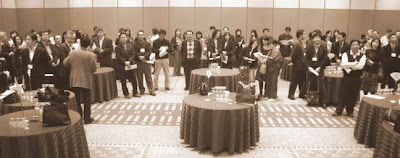I am teaching a technical course at the graduate school of computer science of Osaka University. The course details are described by my lecture notes http://micketoh.web.fc2.com/lecture_notes.htm (English lectures will be available upon your request.)
Jan. 29th was the last day of the class. That means I completed three-day lectures for FY2008 program. As you can see at the notes, my lectures consist of 1. technology and application trends in mobile communication, 2. mobile network architecture, 3. mobile internet, 4. servers in light of Google platform, 5. energy consumption issues in green IT development, 6. multimedia coding technologies including audio and video coding standards,7. international standardization organization inside and outside, 8. handset architecture, 9. AAA (Authentication, Authorization, Accounting)in mobile communication, 10. near field communication for e-commerce, 11. location oriented services, and 12. search technologies. The amount of the contents might go longer than 12-day-long lectures.
For example, my lecture of “multimedia coding technologies including audio and video coding standards” originally requires three days, while AAA in mobile communication may require also more than three days since it needs students to understand cipher technologies, PKI(public key infrastructure), challenge-and-response, etc. I squeezed the total contents into 1/10, which is a huge compression ratio in lectures. My students had a tough time in cramming the contents, where a new topic was discussed every single hour.
Here is a few parting thoughts.
I focused on explicitly teaching how to get onto real and real practical research topics by taking good examples in mobile communication area, and tried to attract the needs of the advanced students. “Research for research” in other words “artificially created research activity just for academic papers” has been completely out of scope of my lectures. So far, I am not sure how it worked.
The other thing is to realize the students importance of predicting the future. That is not an easy job or a task doable through the Google search engine which explores the world-wide archives. This is because future prediction has not been written yet. And only experts who are knowledgeable with insights in market demands and technology trends can do that.
In 2006, I predicted, together with my colleagues, the ways of news papers and CD deliveries would be replaced by another way with mobile communication in 2012.
The technology enablers are 3G Long Term Evolution(3G LTE) broadband wireless and display technologies. Here is a sign of that trend. An ipod software shows me a nation-wide news paper every morning with no charge. At this moment, that content delivery has been enabled by WiFi and ipod-touch though, the future eventually come around us (see also http://en.j-cast.com/2008/12/29032905.html).
The future is at the next corner.












